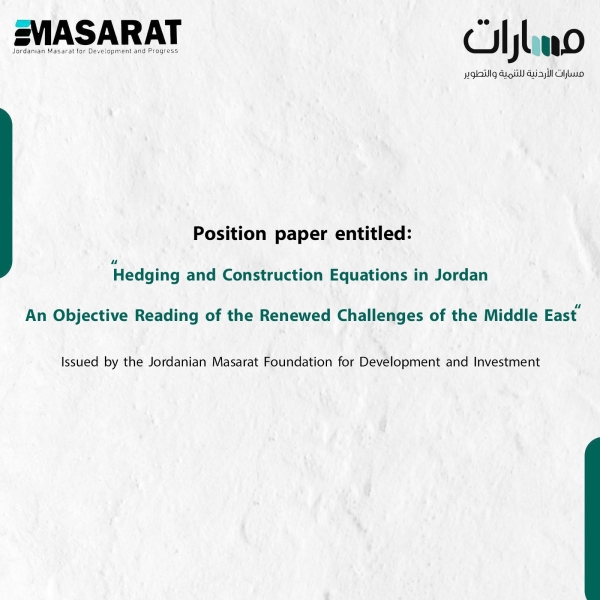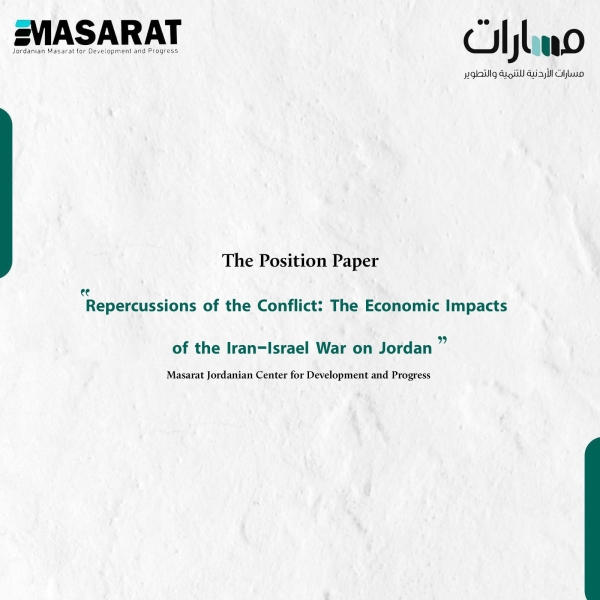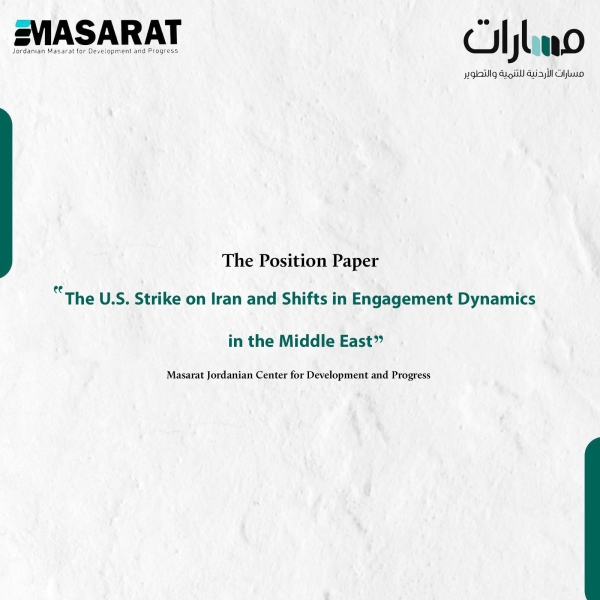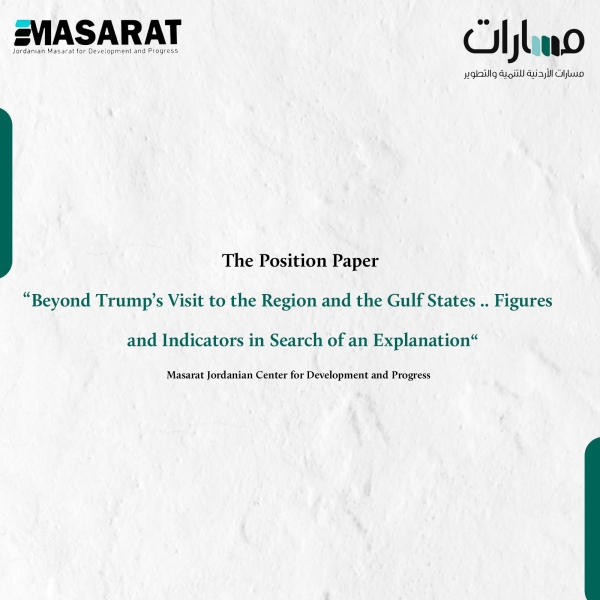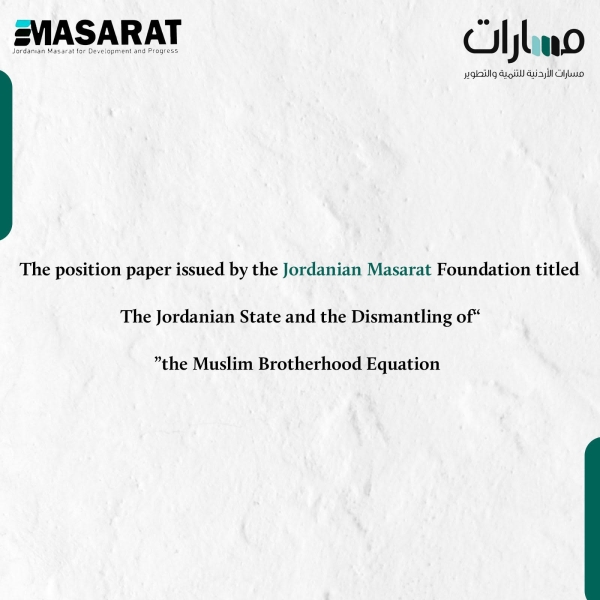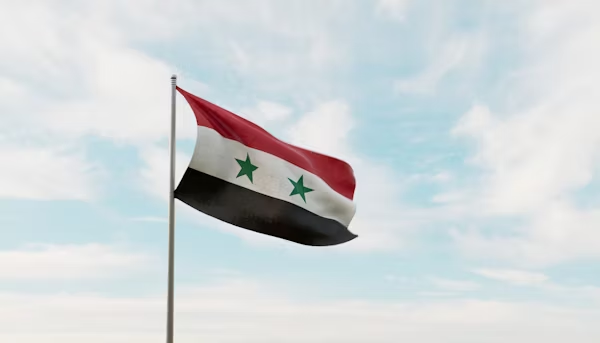Iran and Israel: The Struggle for Influence and Its Intertwined Impact on Regional Stability
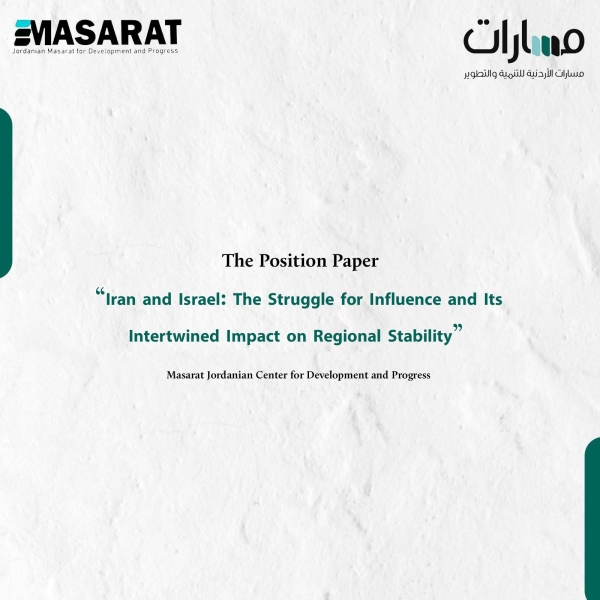
Introduction:
At a moment of acute political sensitivity and within an extraordinarily complex and interconnected regional context, this paper follows a session held by Masarat Jordan for Development and Progress, which thoroughly examined the dimensions of the mutual military escalation between Iran and Israel. This escalation represents a pivotal juncture that is redrawing the contours of strategic engagement in the Middle East and opening the door to unprecedented shifts in regional influence maps and geopolitical centers of gravity.
The ongoing exchange of strikes between Tehran and Tel Aviv can no longer be understood merely within the framework of deterrence or as overlapping security messages. Rather, it reflects a tangible shift toward a new, overt mode of conflict—one that directly threatens the already fragile structure of regional stability and produces dangerous repercussions for neighboring countries, foremost among them Jordan. Once again, Jordan finds itself facing a complex challenge: safeguarding its national security, maintaining its strategic neutrality, and preventing its entanglement in equations that do not concern it.
The session provided an open analytical space, bringing together a distinguished group of former decision-makers, political and military analysts, and regional security experts. The discussion centered around several core questions:
- Was the recent Iranian strike part of a carefully prepared strategic plan, or merely a reactive response shaped by internal and external pressures?
- To what extent can these developments be considered a turning point for the Iranian regime? And how do they relate to the restructuring of the regional order in the wake of the Abraham Accords and their consequences?
- Does this escalation reflect the actual collapse of the nuclear agreement project, or is it a maneuver to return to negotiations under new conditions imposed by force rather than diplomacy?
In contrast, Jordan’s position emerged as a model of strategic wisdom and sovereign restraint. The country reaffirmed that it will not be a part of the conflict nor a passageway for any of the involved actors. This stance is grounded in a well-established framework of principles: protecting Jordanian airspace, fortifying the domestic front against rumors and incitement, and firmly rejecting any attempt to turn the Kingdom into a battlefield for others' conflicts.
This position coincided with a clear and direct political speech delivered by His Majesty King Abdullah II before the European Parliament, which starkly reflected the moral deterioration in the conduct of certain international actors. The speech exposed the hypocrisy of standards that dominate the global order, particularly with regard to the rights of the Palestinian people—the central issue for both Jordan and the region.
This paper serves as a preliminary analytical document that presents to decision-makers and interested researchers the key ideas, insights, and strategic assessments that emerged during the session. It aims to lay the groundwork for a more coherent Jordanian position and a clearer regional vision, in light of the growing erosion of traditional deterrence frameworks and the reconfiguration of alliances—a process that signals the Middle East is entering a new phase, defined by “naked power and postponed diplomacy.”
Chapter One: The Clash of Grand Projects... The Map of Israeli Dominance and the Erosion of Iranian Options
The victory of either party in the conflict—Israel or Iran—does not serve Jordan's interests nor enhance its stability. Whether it is a complete Israeli victory with its catastrophic consequences for the region, or—though unlikely—an Iranian ascendancy that would impose an alternative project no less dangerous, the current equation is clearly skewed in favor of Israel, which enjoys direct military and intelligence support from the United States.
What Israel has done would not have been possible without explicit American backing—beyond mere political approval—to include logistical and intelligence support, satellite coverage, and even involvement in shaping the very objectives of the attacks.
The recent Israeli assault on Iran appears aimed at achieving one of two strategic objectives: either the full subjugation of Iran according to Israeli-American terms regarding its nuclear program and missile capabilities, or the dismantling of the Iranian regime itself as part of engineering a “New Middle East” in which there is no room for any independent or resistant regional power outside the Western or Israeli vision.
Remarkably, these terms are not presented to reach an agreement but rather as a negotiation trap designed to provoke a predictable Iranian rejection. This rejection, in turn, serves as a pretext for further escalation and systematic destruction, contributing to Iran’s exhaustion and its removal from regional power equations.
Despite Iranian statements expressing a desire to end the current round of escalation, Tehran understands that it faces an adversary that surpasses it in intelligence, technology, and military strength, enjoys broad international support, and is not interested in reestablishing a deterrent balance, but rather in dismantling it entirely.
In this context, Jordan's position is viewed as one of the most balanced and rational. It condemned the Israeli assault in alignment with international legal principles, while also intercepting drones and missiles that violated Jordanian airspace, affirming the state’s right to defend its sovereignty and the safety of its citizens. Furthermore, Jordan’s decision to prevent Israeli aircraft from using its airspace—unlike other countries—highlights the steadiness of its stance, which categorically rejects being drawn into a conflict between two external powers.
Jordan, along with most Arab and Islamic states, does not possess the luxury of direct involvement in this conflict, nor the practical tools to make a strategic difference within it. Therefore, demands for Jordan to play a role beyond its realistic capacities reflect a shallow understanding of the complexity and delicate balance of this phase.
Iran’s failure to deter the aggression, or to follow through on its threats of severe retaliation, deepens the crisis facing the Iranian project and exposes it to strategic vulnerability. It reveals that the bets placed on Iran's ability to establish a deterrent balance with Israel were fundamentally exaggerated—or based on a flawed assessment of the actual situation.
Chapter Two: Fragmentation of Narratives and the Reality on the Ground – Between Deconstructing the Myth of Israeli Superiority and Invoking Global Balances
One of the most prominent cognitive shifts resulting from this round of escalation is the gradual retreat—albeit partial—of the stereotypical discourse built on “conspiracy theory”, which used to describe the Iran–Israel dynamic as nothing more than a political performance. This view is now weakening in the face of complex field developments that defy oversimplification or distortion, and in light of mounting evidence that what is happening is not a simulation but rather a real confrontation between two conflicting regional projects with opposing interests and ideologies.
Public analysis has often been shaped by Israel’s initial strike—a highly effective intelligence and security breach that resulted in the assassination of key IRGC commanders, disrupted Iran’s command-and-control systems, and even targeted top scientists. However, a narrow focus on this attack, while ignoring Iran’s unprecedented retaliation, has contributed to a distorted and incomplete reading of the emerging strategic landscape.
The presence of U.S. naval deployments and the fluctuating rhetoric of Israeli leadership suggest that Tel Aviv does not possess the degree of control often assumed and remains highly dependent on full American backing to continue its operations. Moreover, the notion of “eliminating Iran” or “turning the page on Iran” seems closer to propaganda rhetoric than political realism. Iran is a major regional power—it cannot simply be erased or uprooted as a political and military entity.
This raises a critical question: Who pays the price for this war? Ultimately, it is the people who suffer, and it is Arab and Islamic territories that become the arena for the exhaustion of opposing regional and global agendas. Meanwhile, the Arab side—unfortunately—remains a spectator in a battle playing out along its borders and within its strategic sphere.
Chapter Three: The Absence of an Arab Project and the Challenges Facing Jordan Amid Regional Transformations
While regional and global powers continue to advance their strategic agendas—from Iran and Turkey to Israel, China, Russia, and the West—the Arab scene appears more reactive than proactive, marked by fragmentation rather than coordination.
This regression has serious repercussions for Arab national security, especially in historically pivotal states like Lebanon, Iraq, Sudan, Somalia, and the Maghreb. The security breaches Iran is experiencing—despite its decades-long rhetoric of confronting the “Great Satan” and supporting the Palestinian cause—reveal deep internal fragilities, compounded by widespread popular unrest and a weakening social base for the regime.
As Israeli threats intensify—manifested in its growing military reach across the Arab neighborhood, including operations just 10 kilometers from Damascus, strikes deep into southern Lebanon, and entanglement in Yemen—a scenario of "war of attrition" emerges as a possible path forward. However, it does not change the reality that the balance of power still decisively tilts in Israel’s favor.
In this context, a vital question arises: Is it in the Arabs’ interest for Iran to be defeated at this stage? From a pragmatic perspective, the existence of a regional balance—even if it is not entirely desirable—may help preserve a minimal level of deterrence in the absence of a unified Arab project, which makes a political solution the only viable alternative.
As for the Jordanian case, the official position is grounded in firm constitutional principles that reaffirm full national sovereignty and reject the use of Jordanian territory as a corridor or platform for any regional aggression, whether through airspace or borders. This position is further anchored in international law, UN charters, and the Chicago Convention on International Civil Aviation, establishing that the protection of Jordan’s airspace is a sovereign duty that permits neither reinterpretation nor delegation.
Chapter Four: Israeli Intelligence Superiority vs. Emerging Contours of a New Middle East
Current data suggests that Israel, with direct technological and intelligence support from the United States, is achieving qualitative superiority in its confrontation with Iran, whether through cyber operations or air dominance.
This superiority, backed politically by Washington, is not solely aimed at limiting Iran’s capabilities. It goes further to entrench a new strategic reality in the region, one that is decisively tilted in favor of the Israeli-Western axis.
According to recent remarks by former President Donald Trump, the United States is not seeking a negotiated settlement as much as it is pressuring Iran toward submission and surrender. This reinforces the hypothesis that the ongoing war—despite its noise—may ultimately end in an agreement that consolidates Israeli gains and weakens Iran’s bargaining power.
Nevertheless, Israel’s advantage has limits. It lacks the luxury of prolonged exposure to missile strikes or domestic pressure. Given that its population and economy are concentrated in limited geographic areas such as Tel Aviv and Haifa, the risks are significant. The Israeli government recently registered over 20,000 compensation claims due to war-related damages.
In this context, the conflict will likely be decisively resolved within two weeks, unless unexpected battlefield developments disrupt the current balance. Regardless, the political and strategic outcomes will be significant: the war could grant Israel a new regional dominance that may be used to shape the contours of a “New Middle East” based on a Zionist vision—including the annexation of the West Bank, dismantling of regional resistance forces such as the Popular Mobilization Forces (PMF) and the Houthis, and a reconfiguration of regional alliances, with a potentially prominent Saudi role in the post-war phase.
For Jordan, the looming threat may take the form of “slow displacement” of Palestinians from the West Bank through economic and social pressure, especially given Israel’s lack of intent to establish an independent Palestinian state, and its preference for isolated population cantons under Israeli security control. This scenario would require Jordan to seriously reassess its political and diplomatic strategies, including fortifying its domestic front, enhancing national resilience, and anticipating the consequences of annexation.
Chapter Five: The Crisis of the Arab Project and the Need to Strengthen the Domestic Front
The Arab world continues to suffer from the absence of a clear, unified project to drive its collective action. Many segments of Arab youth—particularly active on social media—still hold onto a traditional perception that an external savior will rescue the Palestinian cause. However, this inherited belief, passed down through generations, lacks grounding in real-world developments and is increasingly detached from the current geopolitical reality.
We live in a region undergoing intense turmoil, where former constants are shifting, and conflicts are evolving from proxy wars into direct confrontations, and in some cases, toward outright annihilation. This volatile context is further complicated by the complete absence of an inclusive Arab strategy, capable of containing crises or offering effective long-term solutions.
In this setting, we watch with concern as societies lose their moral compass, a theme His Majesty King Abdullah II recently emphasized in his public address. This erosion of moral clarity is clearly reflected on both political and social levels, deepening the scale of challenges facing Jordan and the broader region.
In Jordan, economic and environmental challenges continue to intensify, particularly with the tourism sector—a key component of the national economy—potentially facing a serious downturn due to the repercussions of regional conflicts, supply chain disruptions, and fluctuations in oil and gas prices. These directly impact Jordan’s already fragile economic conditions.
On the security front, both Jordan’s northern and southern borders are experiencing genuine attrition. The Jordanian Armed Forces and security agencies are under immense material and human pressure, compounded by regional instability, the continued influx of security threats, and the spread of drug trafficking networks. These realities place Jordan in a state of constant defensive engagement, demanding robust internal support and resilience.
Chapter Six: The Strategic Framework of the Iran–Israel Conflict and Its Regional Implications
The behavior of political and military leaders in Iran reflects a clear level of complicity, rooted in internal dysfunction within the Iranian regime itself, compounded by the complex intelligence penetration of Mossad inside Iranian territory. Israel’s primary objectives go beyond the open destruction of nuclear capabilities; they extend to dismantling Iran’s entire systemic structure—an undeclared objective carried out from both inside and outside Iran as part of an integrated strategy.
For nearly four decades, Israel has conducted preemptive strikes on Iranian nuclear facilities, yet it has still not managed to reach what is referred to as “400 grams of enriched uranium,” largely due to the technical limitations of even the most advanced aircraft like the B-2, which lack the precision necessary for such targets. However, research reactors and scientific centers have suffered major damage, significantly reducing Iran’s nuclear capacity.
In parallel, multiple international diplomatic and political efforts are pressuring Iran to accept American proposals, with mediation efforts from Russia, Saudi Arabia, the UK, and France. A limited Iranian acceptance is expected—possibly in exchange for partial sanction relief in return for limited concessions, paving the way for a new round of negotiations.
Israel’s success in executing the first strike is largely attributed to meticulous planning and strict secrecy, as well as strategic deception through media blackout and disinformation, including attempts to reassure both Americans and Iranians that no attack would occur. This falls within the framework of strategic deception, which effectively achieved deterrence.
On the other hand, Iran’s inability to respond effectively to this attack signals a major strategic shock, particularly following the loss of top military leaders and scientists. Iran’s air defense system, burdened by aging infrastructure and technological deficiencies due to sanctions, failed to repel the assault.
This decline in defensive capabilities exposed the weakness of Iran’s conventional weaponry. No credible air interception of the attacking aircraft occurred, casting doubt on Iranian claims that it had downed advanced aircraft like the F-35—an assertion widely regarded as technologically implausible.
Regionally, tensions are rising and crises are escalating, particularly along Israel’s borders. Jordan, which shares the longest border with Israel, faces direct threats from Israeli annexation plans in the Jordan Valley, including the construction of a heavily funded electronic barrier—posing a clear threat to Jordan’s national sovereignty.
Meanwhile, in the Palestinian resistance front, Gaza, Lebanon, Syria, and Iraq have suffered widespread destruction, leaving the resistance landscape fractured and weak, with no unified leadership. This reality forces us to acknowledge that individual operations are on the rise, but there is no clear organizational capability from groups like Hamas or others.
Amid this instability, sectarian tensions between Sunnis and Shiites are escalating, with external powers seeking to inflame internal conflicts—exacerbating security turmoil and threatening civil peace.
Additionally, the rising prices of oil and gas, coupled with threats to close the Strait of Hormuz, add yet another layer of economic complexity to the region, intensifying pressure on stability and development.
In light of these developments, future scenarios may be summarized into four potential paths:
- Continued escalation,
- Reaching diplomatic settlements,
- Collapse of the Iranian regime,
- Transformation of the region into open conflict zones, leading to further human and material exhaustion.
Chapter Seven: Jordan’s Domestic Front – Between Infiltration Threats and the Risks of Displacement
Amid accelerating regional events, Jordan’s official position, articulated by His Majesty King Abdullah II before the European Parliament, emerged as a bold stance that places a moral and political responsibility on the international community—especially European countries—regarding the ongoing crisis in Gaza, Palestine, and the broader region, in light of the global retreat from values of freedom, democracy, and human rights.
However, despite the consistency of Jordan’s official position, it brings to light a renewed internal challenge: the urgent need to fortify the national front. The state has previously succeeded in building strong societal resilience in the face of growing challenges, yet legitimate questions are now being raised about the extent of national immunity against infiltration—whether from regional actors like Iran or hostile intelligence agencies such as Mossad.
In this regard, the geopolitical pressures imposed on Jordan are longstanding—beginning with the Gulf War, the U.S. invasion of Iraq, the Syrian crisis and compounded refugee flows, and now the escalating confrontation between Israel and Iran. All these events have exceeded Jordan’s capacity—politically, economically, and demographically.
The refugee issue, particularly regarding Syrians, continues to impose sustained pressure and raises fundamental questions about their future: Will they return to their countries, or will they become a permanent component of Jordan’s national fabric? These are no longer theoretical questions—especially in light of settlement plans on the ground that do not include the establishment of a genuine Palestinian state, but instead offer isolated, militarized cantons surrounded by settlements. This effectively confiscates the land and dismantles the Palestinian cause, with the potential consequence of gradually displacing Palestinians east of the Jordan River.
In this context, Jordan’s ability to remain outside the sphere of direct impact is becoming increasingly difficult, especially in light of growing indications of the annexation of the Jordan Valley and Israel’s bypassing of the 1974 agreement on the Golan Heights. All signs suggest that the future holds field and political transformations that directly affect Jordan’s national interests.
Chapter Eight: On the Importance of Fortifying the Domestic Front and Reassessing the Regional Landscape
As the war continues and its repercussions grow, there is rising concern about the lack of popular engagement with the nature of escalating regional threats. Indicators suggest a diminished sense of danger among segments of the public, which calls for a national mobilization to reinforce collective awareness of the gravity and sensitivity of this phase.
In this context, emphasis is placed on the need to strengthen internal cohesion among all political and social components, moving beyond institutional and partisan disagreements in favor of a unified national position that supports both the political and military roles of the state. Supporting the armed forces—stationed at the borders amid critical regional conditions—is a national duty that goes beyond symbolic gestures; it constitutes a foundation for the resilience of the domestic front.
Amid ongoing military and technological shifts, it is important to recognize the limited capacity of non-central actors in the region to keep up with Israel’s technological superiority, especially in light of unrestricted U.S. support. Nevertheless, the model of “technology neutralization” adopted by some irregular organizations (such as Hamas) stands out as a form of resistance that has confounded the adversary, despite constrained resources.
It is worth noting that Israel—under international cover—appears to be moving forward with objectives that go beyond military aims, approaching the realization of what could be described as its “expansionist ambitions,” especially amid the decline of traditional centers of power in the region, particularly those aligned with the Iranian axis.
Despite claims about the fragility of the Israeli soldier, field data indicates that the Israeli military establishment is capable of withstanding the cost of prolonged confrontation. This raises the possibility of a drawn-out conflict and amplifies regional challenges, especially for Jordan.
Conclusion
In light of the above, it becomes clear that the current regional landscape is characterized by a complex interplay of security, political, and economic dimensions, with the Iran–Israel confrontation serving as a critical axis affecting the stability of the entire region. The dismantling of Iran’s systemic structure and attempts to strike its nuclear capabilities are only one part of a broader strategic game—one with deeply dangerous implications for neighboring states, foremost among them Jordan.
The ambiguity and volatility surrounding the region’s future call for constant vigilance, an ability to analyze multiple scenarios, and strategic planning that balances national interests with regional and international dynamics.
The choice facing Jordan and the wider region lies in how to confront these evolving dynamics: through domestic unity, regional and international cooperation, and preparation for worst-case scenarios, while still aspiring to achieve stability and peace. This is a challenge that demands wisdom, strategic foresight, and a shared commitment.
Issued by: Masarat Jordan for Development and Progress
Date: 19 June 2025

